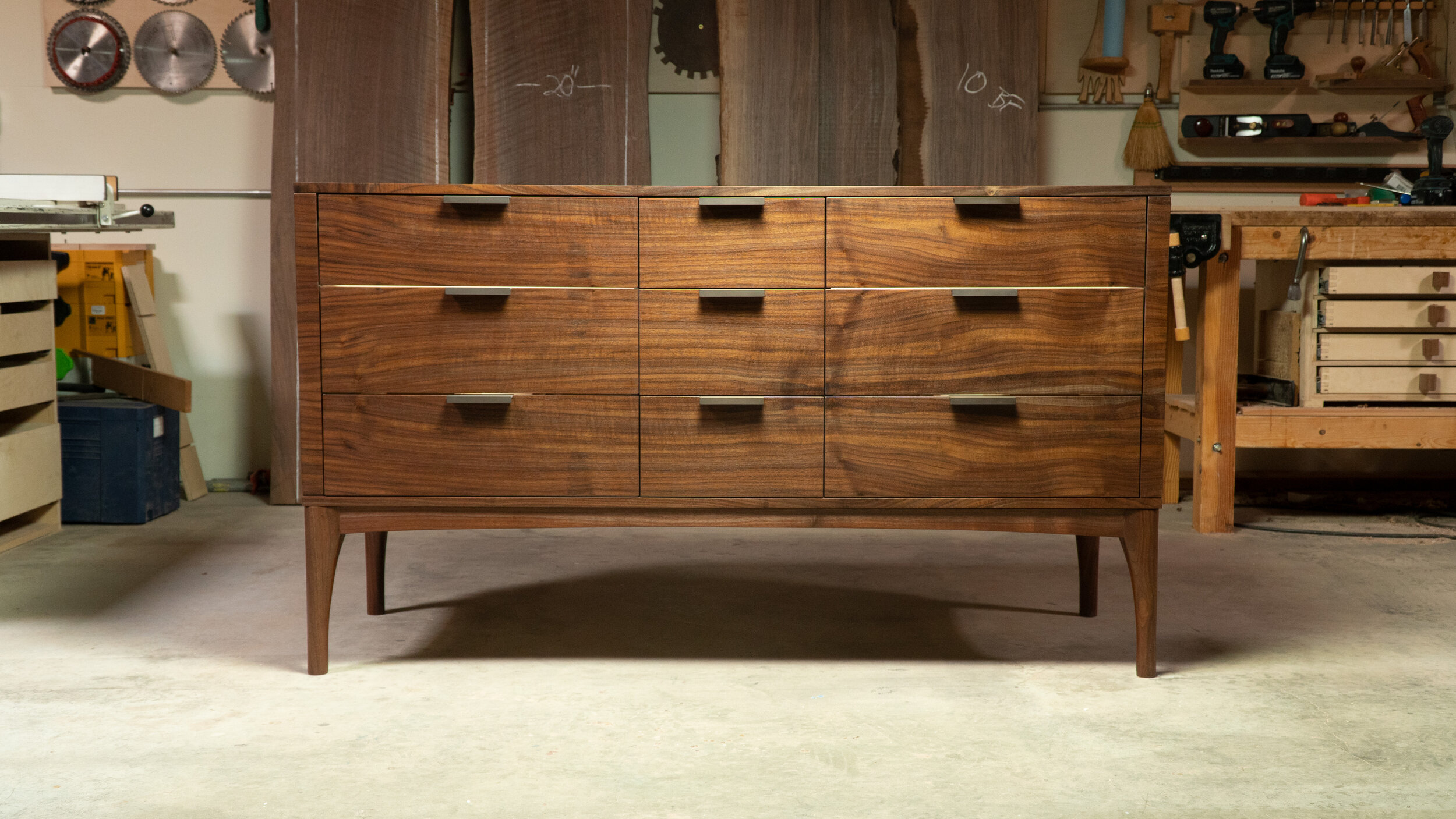Veneer or solid wood--what the...what the heck?
If there’s one thing in furniture making that is held as a universal truth, it’s that a piece made with solid hardwood is better than a piece made with veneer 100% of the time.
“But wait, Joe—don’t you use veneer a lot of your pieces?”
…
…
If there’s one thing in furniture making that is a complicated truth, it’s that veneer is not actually the evil thing woodworking purists sometimes make it out to be—and that both solid wood and veneer have specific applications they’re best suited for. I use veneer because it is the best way I’ve found to design the pieces I want to build, without the draw-backs of sticking to solid wood.
Most people’s experience with veneered furniture is an old piece where the veneer is actually coming off—maybe an end table top bubbling up because of a cup (respect wood!), or a chipped off corner on a dining table. Or almost anything at IKEA. Those pieces shouldn’t represent good veneer though, and anyway maybe you were expecting a little too much out of your $12 dining table.
Here’s the point—
Wood moves. All the time, forever and ever. It expands and contracts with changes in humidity and temperature. A good furniture maker knows this, and designs pieces that takes this into account. That does not mean, though, that you can or should make every component of every piece out of solid wood. Sometimes you want the grain to always line up a certain way, or you have panels that are floating on their own with little support to keep them flat.
That’s where veneer comes in! Solid wood moves, relatively, a lot, while a veneered panel moves much less. The thinner the panel, the easier that solid wood piece will want to twist and warp. Also, the larger the panel of solid wood—especially width, across the grain—the more you have to worry about the panel cupping. The grain in each of those pieces is going in different directions, the wood may have hidden tensions from sitting inside a tree branch for 60 years, or the maker may just situate the boards in an unfortunate pattern that lines all of those board’s future movement up in a non-ideal combination. You can slap a support on the back of the panel—say, a cabinet door—but that only stiffens the panel to the degree that support (batten) can keep it flat.
Veneer doesn’t have that problem. You start with a substrate that is ideally already flat—usually a piece of manufactured plywood that has solved most of those movement issues through a lot of pressure, heat and glue. When you glue a thin layer of solid wood onto a piece of plywood (using the right kind of glue), you’re making a solid slab that looks like solid wood but doesn’t have the hidden tension factor.
A Quick Tangent.
There’s another huge reason—possibly the main reason, with the above added as reverse justification—that I use veneer:
Grain-wrap Vanity, January 2020
All of the wood that covers the front and sides of this cabinet—60” wide, 22” deep, about 22” tall—came from a single board that was 60” long, 8” wide and 1-1/2” thick. That cabinet was made with shop-sawn veneer, or veneer that I resaw (slice very thin layers) from solid boards into 1/16 to 3/32” thick veneers. That’s much thicker than commercially-produced veneer, and much more durable. The ability to take a single board and make an entire cabinet out of it—and get the very cool book-matched grain, and continuity of character throughout the piece—is huge.
Most of the lumber I’m buying is local wood—a lot of times western walnut. It’s a great day when I can find ten boards that came from the same tree, with matching color and grain. But most of the time there’s a board or two that match, and another three that came from a totally different type of soil, and a third character of grain that’s really red compared to the others—western walnut varies a ton depending on where it was grown. If you want the whole piece to have a clean look, this is one way to achieve it.
Veneer is not perfect
So veneered panels tend to stay flatter, and they use the valuable material more efficiently. Why isn’t everything veneered then? Because it’s really difficult to do. It’s easily triple the time to make a veneered panel compared to a solid wood panel, if not more. You start at the same place—rough lumber—but instead mill that flat, resaw into layers, sand those to final thickness, size the veneers, glue them together to make a sheet, sand again, and then glue onto your substrate—which that in itself has several steps to prep. It’s not the easy choice to make. But, as I said above, it’s the best choice for certain applications.
…and in conclusion…
Veneer is not perfect, and it can be done poorly. But there are far too many averse gut-reactions to the word “veneer”. Veneer—at least the way I’m doing it—is durable, thoughtful and material-efficient. It allows the best part of a tree—maybe even that single perfect board—to shine fully across a full piece. It will stay very close to flat much more easily than solid wood, so for pieces like the grain-matched cabinet above, that grain will continue to line up.

